Indexing & Abstracting
Full Text
Case ReportDOI Number : 10.36811/ojprm.2019.110005Article Views : 18Article Downloads : 23
Pulmonary Blastoma in an adult male
Mohammad A. Alim1*, Dina Abo Alam2, Yaser El Sayed3, Amr Abdellateef4, El Sayed Al Ghareeb5, Mohammad Nafee5, Mohammad El Sayed5, Sami Ba Baker5, Mohammad Eid6, Suzan A. Mageed6 and Sahar El Sayed7
1Professor of Cardiothoracic Surgery at Kaser Al Aini Faculty of Medicine, Cairo University, Egypt
2Head of Anesthesia Department at Abbasia Pulmonary Hospital, Ministry of Health, Cairo, Egypt
3Professor of Cardiothoracic Surgery at the Military Medical Academy, Cairo, Egypt
4Assist. Professor of Cardiothoracic Surgery at the Faculty of Medicine, Mansoura University, Egypt
5Thoracic Surgery Dept. at Abbasia Pulmonary Hospital, Ministry of Health, Cairo, Egypt
6Chest Medicine Dept. at Abbasia Pulmonary Hospital, Ministry of Health, Cairo, Egypt
7Pathology Dept. at Abbasia Pulmonary Hospital, Ministry of Health, Cairo, Egypt
*Corresponding Author: Mohammad A. Alim, Professor of Cardiothoracic Surgery at Kaser Al Aini Faculty of Medicine, Cairo University, Egypt, Email: cardio_thoracic2011@yahoo.com
Article Information
Aritcle Type: Case Report
Citation: Mohammad A. Alim, Dina Abo Alam, Yaser El Sayed, et al. 2019. Pulmonary Blastoma in an adult male. Open J Pulm Respir Med. 1: 23-26.
Copyright: This is an open-access article distributed under the terms of the Creative Commons Attribution License, which permits unrestricted use, distribution, and reproduction in any medium, provided the original author and source are credited. Copyright © 2019; Mohammad A. Alim
Publication history:
Received date: 26 November, 2019Accepted date: 06 December, 2019
Published date: 09 December, 2019
Introduction
Pulmonary blastoma is one of the rare lung tumors and is considered to be distinct from other lung tumors by its pathological features, clinical course and prognosis [1]. Classic pulmonary blastoma is composed of both malignant mesenchymal stroma and epithelial components resembling embryonic lung tissue. Surgery is the standard treatment and the efficacy of adjuvant chemotherapy and radiotherapy has not yet been established [2].
Case Report
Our patient was admitted and managed at Abassia Pulmonary Hospital, Ministry of Health, Cairo Governorate, Egypt. A 37-year-old Egyptian male presented to our hospital after repeated attacks of blood tinged sputum. The first attack dated about 6 months before admission. The patient had progressive shortness of breath over a period of two years. The patient was a smoker of one pack of cigarettes per day for more than 15 years. There was no significant past history nor family history. After admission to the Chest Medicine Department at Abbasia Pulmonary Hospital, routine basic investigations were done including complete blood picture with differential count, fasting blood sugar and 2 hours after meal, liver function tests, renal function tests, and coagulation profile. All investigations were within normal. Sputum examinations for AFB for 3 successive days were done and were all negative. Sputum cytology did not show malignant cells. The P-A view of his chest X-ray showed a well-demarcated right upper and middle lung zones mass. The mass extends to the right lung apex abutting the inner chest wall and medially extended to the mediastinum and the right hilum. The mass has a heterogeneous texture (Figure 1). Chest CT scan (Figure 2) showed a large well defined, heterogeneous right upper lobe mass. The CT showed no significant meditational lymph nodes enlargement. Preoperative fiber optic bronchoscoy showed no endobroncheal pathology. Also, the broncho-alveolar lavage was negative for both AFB and malignant cells. Preoperative CT needle guided biopsy revealed a biphasic pulmonary blastoma with both epithelial and mesenchymal components. Preoperative CT abdomen and bone scintigraphy revealed no evidence of distant metastasis. The patient was referred to the Thoracic Surgery Department at our hospital for resection of the pulmonary blastoma affecting the right upper lung lobe. General anesthesia was conducted via double lumen endotracheal tube for one lung anesthesia. The patient was positioned in the lateral decubitus position with his right side up. Standard right postero-lateral thoracotomy in the fifth space was done. The tumor mass was seen and felt involving the entire right upper lung lobe and sparing both the middle and lower lung lobes. The mass was well circumscribed, lobulated with firm to hard texture. Classic right upper lobectomy was done. After closure of the bronchial stump with simple interrupted Vicryl 20 sutures, the stump was covered using a pedicled intercostal muscle flap as our standard technique in cases of malignancy and TB to guard against postoperative bronch-pleural fistula.
Postoperative pathology report confirmed the diagnosis of high grade biphasic pulmonary blastoma with free bronchial margin, free pleural tissue and negative mediastinal lymph nodes for metastasis. The postoperative course of the patient was uneventful. After removal of the stitches; the patient was referred to the Cancer Institute of Cairo University for evaluation and the possibility of post lobectomy chemotherapy and / or radiotherapy.
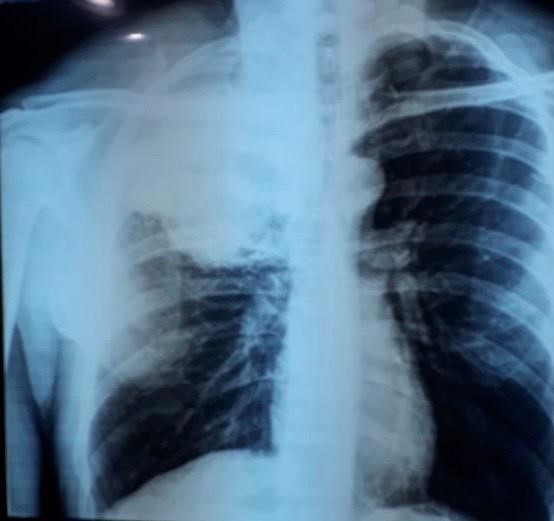
Figure 1: Chest X-ray P-A view showing.
Right upper and mid zonal well-defined tumor mass.
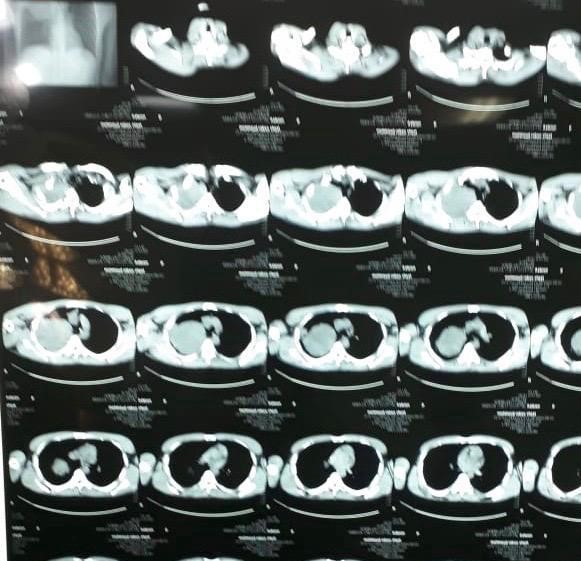
Figure 2: Mediastinal window of CT.
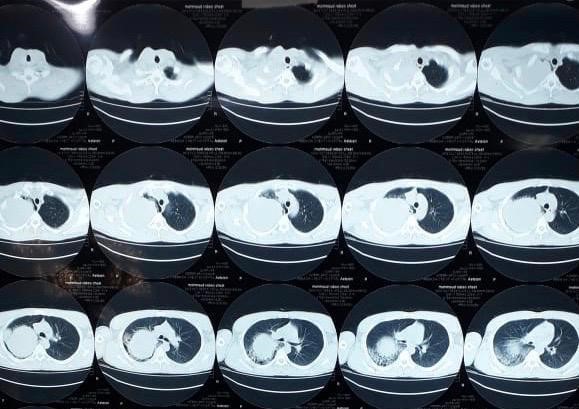
Figure 3: Pulmonary window of CT chest chest showing right upper lobe mass. showing the right upper lobe tumor mass.
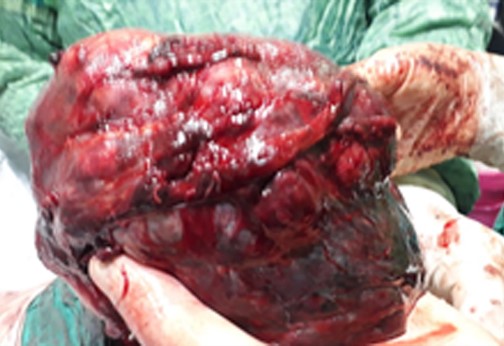
Figure 4: The right upper lobe.
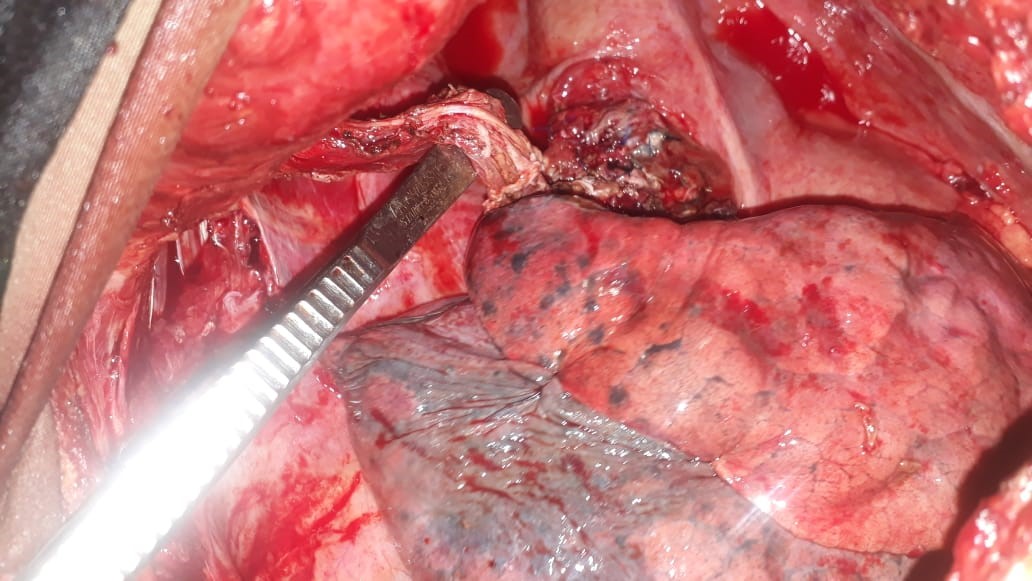
Figure 5: Intercostal muscle flap covering lobulated tumor mass. the bronchial stump.
Discussion
Pulmonary blastoma is a rare primary lung tumor occurring mainly in adults. The incidence is 0.25 to 0.5 % of all primary lung tumors [3]. The tumor was first described by Barrett and Barnard in 1945, and it was termed by Barnard as “embryoma” [4]. The term “blastoma” was suggested by Spencer in 1961 because the pathogenesis of that tumor was believed to be similar to Wilms’ tumor or nephroblastoma [5]. The World Health Organization (WHO) had classified pulmonary blastomas into three categories according to the histopathology, the first type is pulmonary blastoma which is biphasic, the second type is pleuropulmonary blastoma which is monophasic and occurs commonly in childhood and the third type is the well differentiated fetal adenocarcinoma (WDFA) [6].
The etiology and predisposing factors are not still fully understood. But, in the literature, there is strong evidence showing the correlation between cigarette smoking and pulmonary blastoma [7]. Our patient was a smoker of one pack per day for more than 15 years. The peak incidence of biphasic pulmonary blastoma is in the fourth decade of life. About 30% of cases occurring in children and the tumor is known as pleuropulmonary blastoma [8]. The age of our patient at the time of presentation was 37 years old.
Some groups reported a male predominance while others did not [9]. Approximately 60% of patients are symptomatic [10]. Usually biphasic pulmonary blastoma are located in the periphery of the lung, while 25% present with end bronchial tumor [11]. Our patient was a male who complained of blood tinged sputum and the tumor was proved by pre and postoperative histopathology to be a biphasic peripheral pulmonary blastoma. The radiological appearance of pulmonary blastoma is usually a solitary pulmonary nodule or a mass with a smooth margin due to the desmoplastic changes surrounding the tumor. Rarely the tumor cavitates, calcified or be multiple [12].
Preoperative tissue diagnostic procedures e.g. bronchoscopy, mediastinoscopy, CT needle guided biopsy usually cannot diagnose pulmonary blastome due to lack of cellular material and extensive necrosis of the tumor [13]. In our patient CT guided biopsy could diagnose the tumor to be biphasic blastoma and this histopathology was confirmed by the postoperative histopatopathological examination. The standard treatment of pulmonary blastoma consists of surgical resection [14]. Our patient had a resectable tumor and a right upper lobectomy was performed. Due to the lack of data, adjunctive therapy with chemotherapy and / or radiotherapy is still controversial [9]. Our patient was referred to Cancer Institute of Cairo university for further evaluation of his need for adjunctive therapy or not. The prognosis of pulmonary blastoma is poor regardless of the histology. The overall 5 years survival was reported to be 16 % [15]. Another study the researchers had reported that biphasic pulmonary blastomas have a poorer prognosis than the monophasic well differentiated fetal adenocarcinoma which have a better prognosis and a five years survival around 50% [16]. The factors contributing to the unfavorable prognosis are the biphasic type, tumor recurrence, metastatic disease on presentation, tumor size more than 5 cm, and frequent lymph node involvement [17].
References
1. Alahwal MS, Maniyar IH, Saleem F, et al. 2012. Pulmonary blastoma: rare primary lung malignancy. Case Report in Medicine. 4. Ref.: https://rb.gy/bdbjxn
2. Walker RI, Suvarna K, Mathews. 2005. Pulmonary blastoma: presentation of two atypical cases and review of the literature. Br J Radiol. 78: 437-440. Ref.: https://www.ncbi.nlm.nih.gov/pubmed/15845939
3. Colby TV, Koss MN, Travis WD. 1952. Tumors of the lower respiratory tract. Bethesda, MD: American Registry of Pathology, Armed Forces Institute of Pathology, 1995:395-417.
4. Barnard WG: Embryoma of the lung. 7: 299. Ref.: https://www.ncbi.nlm.nih.gov/pmc/articles/PMC1019196/
5. Spencer H. 1961. Pulmonary blastoma. J Pathol. 82:161.
6. Brambilla E, Travis WD, Colby TV et al. 2001. The new World Health Organization classification of lung tumors. Eur Respir J. 18: 1059-1068. Ref.: https://www.ncbi.nlm.nih.gov/pubmed/11829087
7. Zaidi A, Zamvar V, Macbeth F, et al. 2002. Pulmonary blastoma: medium term results from a regional center. Ann Thorac Surg. 1572-1575. Ref.: https://rb.gy/0uwioy
8. Ozkaynak MF, Ortega JA, Gilsanz V, et al. 1990. Role of chemotherapy in pediatric pleuropulmonary blastoma. Med Pediatr Oncol. 18 :53-61. Ref.: https://www.ncbi.nlm.nih.gov/pubmed/2152957
9. Liman ST, Altinok T, Topcu S, et al. 2006. Survival of biphasic pulmonary blastoma. Respiratory Medicine.100: 1174-1179. Ref.: https://rb.gy/wufnza
10. LeMense GP, Reed CE, Silvestri GA. 1996. Pulmonary blastoma: a rare lung malignancy. Lung Cancer. 5: 233-237. Ref.: https://www.ncbi.nlm.nih.gov/pubmed/8882990
11. Berho M, Moran CA, Suster S. 1995. Malignant mixed epithelial/mesenchymal neoplasms of the lung. Semin Diagn Pathol. 12: 123-39. Ref.: https://www.ncbi.nlm.nih.gov/pubmed/7638446
12. Lee HJ, Goo JM, Kim KW, et al. 2004. Pulmonary blastoma radiologic findings in five patients. Clin Imag. 28: 113-118. Ref.: https://www.ncbi.nlm.nih.gov/pubmed/15050223
13. Robert J, Pache JC, Seium Y, et al. 2002. Pulmonary blastoma: report of five cases and identification of the clinical features suggestive of the disease. Eur J Cardiothorac Surg. 22: 708-711. Ref.: https://rb.gy/o0ygfe
14. Le Caer H, Venissac N. 2018. Classic biphasic pulmonary blastoma: A case report and review of literature. Crit Rev Onc Hemat. 125: 48-50. Ref.: https://rb.gy/nyiw5k
15. Adluri RKP, Boddu SR, Ucar AM, et al. 2006 Pulmonary blastoma-a rare tumor with variable presentation. Eur J Cardiothorac Surg. 29: 236-239. Ref.: https://rb.gy/maerui
16. Koss MN, Holchholzer L, O’Leary T. 1991. Pulmonary blastomas. Camcer. 67: 2368-2381.
17. Cutler CS, Michel RP, Yassa M, et al. 1998. Pulmonary blastoma: case report of a patient with a 7-year remission and review of chemotherapy experience in the world literature. Cancer. 82: 462-457. Ref.: https://www.ncbi.nlm.nih.gov/pubmed/9452262




















